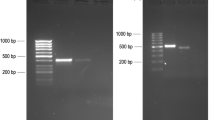Abstract
Granulomatous amoebic encephalitis (GAE) is a usually fatal disease caused by the free-living amoebae Balamuthia mandrillaris and Acanthamoeba spp. The intent of this study was to determine if the polymerase chain reaction (PCR) could be used retrospectively to detect amoeba mitochondrial 16S ribosomal ribonucleic acid gene deoxyribonucleic acid (DNA) in confirmed archival tissue sections from GAE cases stored in our laboratories for 1 to 34 years. The DNA was extracted from deparaffinized sections, and appropriate primer sets for each of the two amoebae were used for DNA detection. Indirect immunofluorescent staining (IIF) of tissue sections was used as the standard for identification of amoebae against which the PCR results were compared. Sixty slides from a total of 56 cases were processed by PCR for amoeba 16S DNA. In 28 (47%) slides, there was agreement between the IIF and PCR results. In 41 of the slides (52%), no DNA was detected after PCR. In one slide (1%), the PCR and IIF results did not agree. While PCR supported IIF findings in about half of the slides, there are significant limitations in amoeba DNA identifications in formalin-fixed brain tissues. Degradation of amoeba DNA because of formalin fixation was probably a factor in limiting valid results.



Similar content being viewed by others
References
Anzil AP, Chandrakant R, Wrzolek MA, Visvesvara GS, Sher JH, Kozlowski PB (1991) Amebic meningoencephalitis in a patient with AIDS caused by a newly recognized opportunistic pathogen. Arch Pathol Lab Med 15:21–25
Booton GC, Carmichael JR, Visvesvara GS, Byers TJ, Fuerst PA (2003a) Identification of Balamuthia mandrillaris by PCR using the mitochondrial 16S rRNA gene as a target. J Clin Microbiol 41:453–455
Booton GC, Carmichael JR, Visvesvara GS, Byers TJ, Fuerst PA (2003b) Genotyping of Balamuthia mandrillaris based on nuclear 18S and mitochondrial 16S rRNA genes. Am J Trop Med Hyg 68:65–69
Booton GC, Schuster FL, Carmichael JR, Fuerst PA, Byers TJ (2003c) Balamuthia mandrillaris: Identification of clinical and environmental isolates using genus-specific PCR. J Eukaryot Microbiol 50:508S–509S
Candenedo-Gonzalez FA, Gamboa-Dominguez A (2000) Acute amebic thyroiditis by Balamuthia mandrillaris. Patología 38:33–36
Dunnebacke TH, Schuster FL, Yagi S, Booton GC (2004) Balamuthia mandrillaris from soil samples. Microbiology 150:2837–2842
Ferrer I, Armstrong J, Capellari S, Parchi P, Arzberger T, Bell J, Budka H, Ströbel T, Giaccone G, Rossi G, Bogdanovic N, Fakai P, Schmitt A, Riederers P, Al-Sarraj S, Ravid R, Kretzschmar H (2007) Effects of formalin fixation, paraffin embedding, and time and storage on DNA preservation in brain tissues: a BrainNet Europe study. Brain Pathol 17:297–303
Foreman O, Sykes J, Ball L, Yang N, De Cock H (2004) Disseminated infection with Balamuthia mandrillaris in a dog. Vet Pathol 41:506–510
Karlsen F, Kalantari M, Chitemerere M, Johansson B, Hagmar B (1994) Modifications of human and viral deoxyribonucleic acid by formaldehyde. Lab Invest 72:604–611
MacLean RC, Hafez N, Tripathi S, Childress CG, Ghatak NR, Marciano-Cabral F (2007) Identification of Acanthamoeba sp. in paraffin-embedded CNS tissue from an HIV+ individual by PCR. Diagn Microbiol Infect Dis 57:289–294
Martinez AJ, Visvesvara GS (1997) Free-living, amphizoic and opportunistic amebas. Brain Pathol 7:583–598
Rodriques D, Reis M, Teixeira V, Silva-Veraga M, Filho DC, Adad S, Lazo J (1997) Pathologic findings in the adrenal glands of autopsied patients with acquired immunodeficiency syndrome. Pathol Res Pract 198:25–30
Schild M, Gianinazzi C, Gottstein B, Müller N (2007) PCR-based diagnosis of Naegleria sp. infection in formaliln-fixed and paraffin-embedded brain sections. J Clin Microbiol 45:564–567
Schuster FL (2002) Cultivation of pathogenic and opportunistic free-living amebas. Clin Microbiol Rev 15:342–354
Shirwadkar CG, Samant R, Sankhe M, Deshpande R, Yagi S, Schuster FL, Sriram R, Visvesvara GS (2006) Acanthamoeba encephalitis in patient with systemic lupus, India. Emerg Infect Dis 12:984–986
Taratuto AL, Lubieniecki F, Galli S, Valdovinos B, Drut R, Martinez J, Gallo G, Monges J, Visvesvara G (2001) Balamuthia mandrillaris infection from a neurosurgical pediatric series. J Neuropathol Exper Neurol 60:556(abstract)
Tavares M, da Costa JMC, Carpenter SS, Santos LA, Afonso C, Aguiar A, Pereira J, Cardoso AI Schuster FL, Yagi S, Sriram R, Visvesvara GS (2006) First case of Balamuthia amoebic encephalitis in Portugal: case report and diagnosis by immunofluorescence and PCR. J Clin Microbiol 44:2660–2663
Visvesvara GS, Martinez AJ, Schuster FL, Leitch GJ, Wallace SV, Sawyer TK, Anderson M (1990) Leptomyxid ameba, a new agent of amebic meningoencephalitis in humans and animals. J Clin Microbiol 28:2750–2756
Yagi S, Booton GC, Visvesvara GS, Schuster FL (2005) Detection of Balamuthia mitochondrial 16S rRNA gene DNA in clinical specimens by PCR. J Clin Microbiol 43:3192–3197
Yagi S, Schuster FL, Bloch K (2007) Demonstration of presence of Acanthamoeba mitochondrial DNA in brain tissue and cerebrospinal; fluid by PCR in samples from a patient who died of granulomatous amebic encephalitis. J Clin Microbiol 45:2090–2091
Acknowledgments
The research was supported in part by a grant from the Emerging Infectious Diseases Program of the Centers for Disease Control and Prevention (U50/CCU915548-09) to Dr. Carol Glaser of the California Department of Public Health, Richmond, whom the authors thank for her encouragement and support. We thank Rama Sriram (CDC) for her technical expertise and assistance. The research performed in this study was in compliance with the laws of the USA and the authors’ respective institutions.
Author information
Authors and Affiliations
Corresponding author
Rights and permissions
About this article
Cite this article
Yagi, S., Schuster, F.L. & Visvesvara, G.S. Demonstration of Balamuthia and Acanthamoeba mitochondrial DNA in sectioned archival brain and other tissues by the polymerase chain reaction. Parasitol Res 102, 211–217 (2008). https://doi.org/10.1007/s00436-007-0749-7
Received:
Accepted:
Published:
Issue Date:
DOI: https://doi.org/10.1007/s00436-007-0749-7




